| Article ID | Journal | Published Year | Pages | File Type |
|---|---|---|---|---|
| 6386187 | Harmful Algae | 2015 | 19 Pages |
â¢Mechanisms describing the outbreakof red tides were reviewed.â¢Red-tide outbreaks were categorized into a hierarchy of 4 generation mechanisms (GM1-GM4).â¢In GM1, all red-tide species were treated as autotrophic organisms without swimming.â¢In GM2 and GM3, vertical migration and mixotrophy were considered.â¢GM4 contained biological interactions among red-tide species.
Red tides - discolorations of the sea surface due to dense plankton blooms - occur regularly in coastal and offshore waters along much of the world's coastline. Red tides often cause large-scale mortalities of fish and shellfish and significant losses to the aquaculture and tourist industries of many countries. Therefore, understanding and predicting the mechanisms controlling the outbreak, persistence, spread, and decline of red tides are important concerns to scientists, officials, industry, and the public. With increasing knowledge of red-tide species and red-tide events, new mechanisms have been discovered. Based on the nutrition and behaviors of red-tide organisms and biological interactions among them, red-tide outbreaks can be categorized into a hierarchy of four generation mechanisms (GM1-GM4). In the simplest, GM1, all phototrophic red-tide species were treated as exclusively autotrophic organisms without the ability to swim. However, this GM cannot explain red-tide outbreaks in oligotrophic surface waters offshore. Vertical migration (considered in GM2) and mixotrophy (GM3) enable red-tide flagellates to acquire growth factors from nutrient-rich deep waters or co-occurring prey, respectively. In natural environments, all red tides occur by those species outgrowing co-occurring organisms; red-tide species dominate communities by eliminating other species or reducing their abundances. Thus, GM4 contains the direct biological interactions (i.e., inhibition by physical contact or chemical effects) and indirect biological interactions (i.e., acquiring resources faster than others) that can affect the dominance of red-tide species under given conditions. Correctly choosing one of these four GMs for red tides dominated by one causative species is important because the accuracy of predictions may be outweighed by the costs and time required to acquire the relevant information. In this study, mechanisms describing the outbreak, persistence, and decline of red tides were reviewed, the advantages and limitations of each mechanism were evaluated, and insights about the evolution of the mechanisms were developed.
